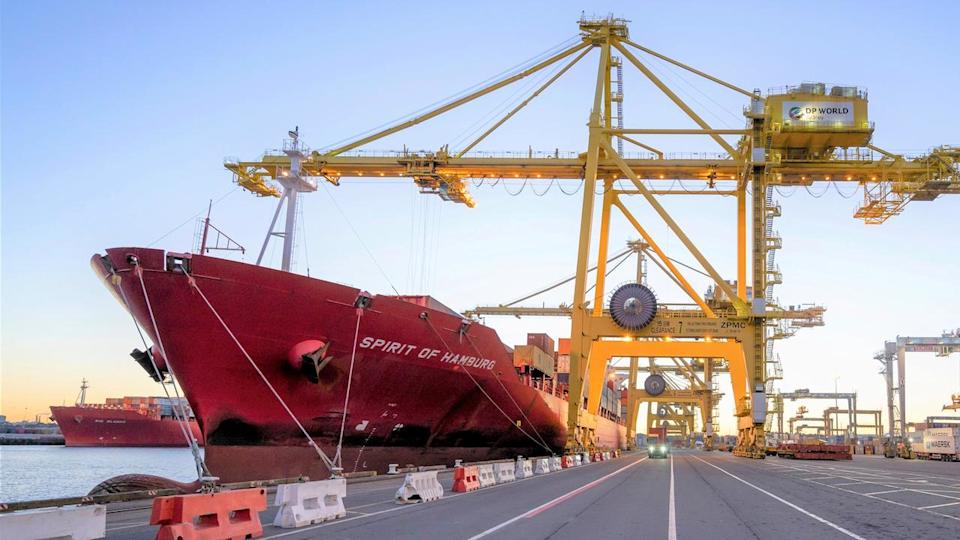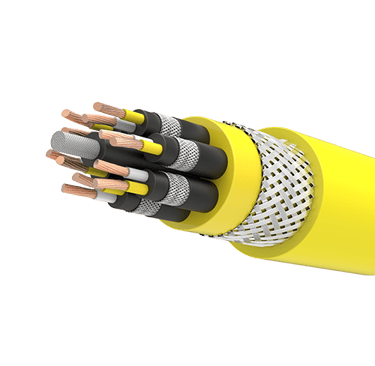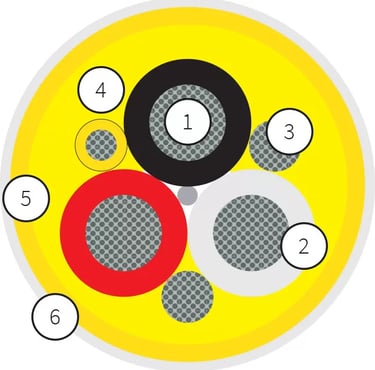📞+86 153 7530 2641 📧 hongjing.Wang@feichuncables.com
AS/NZS 3808 Cable Standard for Port Crane Reeling Cables and Marine Applications
Ensure your port crane systems use reeling cables that meet AS/NZS 3808 standards for insulation and sheathing performance. This guide explains how the standard supports safety, fire resistance, and long-term reliability in marine and crane environments. Discover how compliance reduces downtime and aligns with Australian port infrastructure requirements.
hongjing.Wang
7/11/20257 min read


Introduction: Safety and Reliability in Port Crane Cable Systems
Australia's bustling ports handle millions of tonnes of cargo annually, relying on sophisticated crane systems that demand exceptional cable performance. In these harsh marine environments, crane cables face relentless challenges from high salt spray, extreme mechanical stress, and constant movement cycles that would quickly destroy ordinary cables.
The demanding conditions at ports like Melbourne, Sydney, and Fremantle require reelable cables that can withstand thousands of reeling cycles while maintaining electrical integrity. This is where compliance with rigorous standards such as AS/NZS 3808 becomes absolutely critical for ensuring longevity and safety in port crane operations.
Port crane cable systems must perform flawlessly in environments where failure isn't just costly—it's dangerous. When a ship-to-shore (STS) crane cable fails during container loading operations, the consequences can include equipment damage, cargo delays, and serious safety risks to personnel. Similarly, rubber-tyred gantry (RTG) crane cables and rail-mounted gantry (RMG) crane cables must maintain reliable performance despite constant exposure to salt air, UV radiation, and mechanical stress.
The Australian and New Zealand markets recognise that investing in AS/NZS 3808 compliant crane cables represents sound business practice. These standards ensure that highly flexible cables used in port machinery can deliver the durability and performance required for Australia's critical infrastructure.
What Is AS/NZS 3808 and Why It Matters in Port Equipment
AS/NZS 3808 represents the Australian Standard and New Zealand Standard specifically addressing cable insulation and sheath material properties. This cable standard establishes comprehensive requirements for materials used in industrial cable applications, particularly focusing on the performance characteristics essential for harsh environmental conditions.
The relationship between AS/NZS 3808 and the flexible reeling cables commonly used in port cranes centres on material performance requirements. The standard defines specific criteria for polymer compounds used in cable construction, ensuring these materials can withstand the unique stresses encountered in marine environments.
When comparing AS/NZS 3808 with international cable standards such as IEC 60502 and IEC 60332, several key differences emerge. While IEC standards focus broadly on power cables and fire performance, AS/NZS 3808 standard requirements specifically address the climatic and environmental conditions prevalent in Australia and New Zealand. This includes enhanced UV resistance testing, specific temperature ranges relevant to Australian conditions, and requirements for materials that maintain flexibility in varying humidity levels.
The standard's emphasis on sheath material properties makes it particularly relevant for port crane cable applications. Heavy-duty cables used in reeling applications must demonstrate exceptional resistance to abrasion, ozone, and salt spray—all criteria specifically addressed within AS/NZS 3808.
Understanding these distinctions helps port operators make informed decisions when selecting port crane cables AS/NZS 3808 compliant options. The standard's focus on local environmental conditions means that AS/NZS 3808 certified cables often outperform international alternatives in Australian port applications.


Key Testing Requirements Relevant to Crane Cables
The performance characteristics essential for port crane cables align directly with AS/NZS 3808's comprehensive testing requirements. Heat resistance testing ensures cables maintain their properties under the elevated temperatures common in Australian ports, where equipment operates in direct sunlight and ambient temperatures frequently exceed 40°C.
UV resistance represents another critical performance parameter, particularly for reeling cables that experience repeated exposure during crane operations. The standard's UV testing protocols simulate years of Australian sun exposure, ensuring that cable sheaths won't degrade prematurely in outdoor port environments.
Oil resistance and chemical resistance testing addresses the industrial environment reality where port crane cables encounter hydraulic fluids, lubricants, and various chemicals used in port operations. AS/NZS 3808 applications in harsh environments demand cables that maintain their integrity when exposed to these substances.
Abrasion resistance testing simulates the mechanical stresses experienced during reeling operations. High wear-resistant port crane cables must demonstrate their ability to withstand millions of flexing cycles while maintaining electrical and mechanical integrity.
Flame retardancy requirements ensure that cables won't propagate fire in the event of electrical faults or external ignition sources. This safety consideration becomes particularly important in port environments where cargo handling equipment operates near combustible materials.
The standard's interpretation of material classification focuses on specific compounds like XLPE (cross-linked polyethylene) sheaths, which offer superior performance characteristics for reeling applications. These materials demonstrate excellent tensile strength, ensuring that port reeling cables can handle the mechanical stresses of constant movement without premature failure.
Determining cable compliance involves examining outer packaging for appropriate markings, reviewing certification documents provided by suppliers, and verifying supplier declarations of conformity. How to identify AS/NZS 3808 compliant cables requires understanding these documentation requirements and ensuring all materials meet the specified performance criteria.
Application to Reeling Cables in Port Crane Systems
The typical wiring methods for reeling cables in STS, RTG, and RMG cranes vary significantly based on the specific application requirements. Ship-to-shore (STS) crane cables must accommodate the long travel distances and high lifting capacities required for container vessel operations. These systems typically utilise power cables, control cables, and data cables integrated into a single reeling system.
Rubber-tyred gantry (RTG) crane cables face different challenges, operating in yard environments where they must provide reliable power and control while the crane moves between container stacks. The reeling systems for RTG applications must account for the crane's mobility and the need for consistent electrical performance during positioning operations.
Rail-mounted gantry (RMG) crane cables operate in more constrained environments but still require exceptional durability. These systems often incorporate multiple cable types within a single reeling drum, necessitating careful selection of AS/NZS 3808 cables for container cranes that can maintain performance while sharing confined spaces.
Reeling cables for mobile equipment in ports benefit significantly from AS/NZS 3808 compliance, particularly in reducing torsion core breakage and sheath aging. The standard's material requirements ensure that cable cores maintain their electrical properties despite repeated twisting and flexing cycles. Similarly, the sheath materials specified in AS/NZS 3808 demonstrate superior aging resistance compared to non-compliant alternatives.
Real-world performance data demonstrates the benefits of AS/NZS 3808 flexible cable characteristics in port applications. Case studies from Australian ports show that compliant cables achieve service lives exceeding 10 years in demanding reeling applications. This extended service life translates directly into reduced maintenance costs and improved operational reliability.
The high-flex capabilities of AS/NZS 3808 certified cables make them particularly suitable for modern port crane systems that operate continuously throughout cargo handling operations. These cables maintain their electrical properties through millions of flexing cycles, ensuring consistent performance in demanding industrial applications.
How to Choose Certified Reeling Cables for Port Projects
Selecting port crane cables AS/NZS 3808 compliant options requires a systematic approach that considers both technical specifications and supplier qualifications. The selection process should begin with a thorough assessment of the specific application requirements, including environmental conditions, electrical specifications, and mechanical stresses.
When evaluating suppliers of AS/NZS 3808 certified cables, port operators should prioritise vendors who can provide comprehensive documentation supporting compliance claims. This includes third-party test certificates from recognised testing laboratories, declarations of conformity that specifically reference AS/NZS 3808 requirements, and detailed technical specifications that demonstrate how the cables meet standard requirements.
Cost-effective AS/NZS 3808 cables represent the optimal balance between initial investment and long-term operational costs. While compliant cables may carry higher upfront costs compared to non-compliant alternatives, the extended service life and reduced maintenance requirements typically result in lower total cost of ownership.
Marine grade port crane cables require additional considerations beyond basic AS/NZS 3808 compliance. These applications may require enhanced salt spray resistance, improved UV stability, or specific temperature performance characteristics. Low temperature port crane cables AS/NZS 3808 compliant options become important for ports in southern regions where winter conditions can affect cable performance.
Port crane cable installation guidelines AS/NZS 3808 should be followed meticulously to ensure optimal performance. Proper installation techniques, including appropriate bend radius limits and secure mounting methods, are essential for realising the full benefits of compliant cables.
The safety standards for port cables extend beyond material compliance to encompass proper selection, installation, and maintenance practices. Regular inspection protocols should be established to monitor cable condition and identify potential issues before they result in failures.
Maintenance and Performance Optimisation
Port crane cable maintenance and care AS/NZS 3808 compliant systems require structured approaches that account for the unique challenges of marine environments. Regular inspection schedules should focus on identifying early signs of degradation, including sheath cracking, conductor corrosion, or insulation breakdown.
Preventing port crane cable failure AS/NZS 3808 systems involves proactive maintenance strategies that address the most common failure modes. These include regular cleaning to remove salt deposits, lubrication of reeling mechanisms to reduce mechanical stress, and periodic electrical testing to verify continued performance.
The durability of AS/NZS 3808 cables depends significantly on proper handling and storage procedures. Cables should be stored in controlled environments that protect them from UV exposure and extreme temperatures. During installation, handling procedures should minimise mechanical stress that could compromise long-term performance.
Performance monitoring systems can provide valuable insights into cable condition and help optimise maintenance schedules. These systems track electrical parameters, mechanical stress indicators, and environmental conditions to provide early warning of potential issues.
Conclusion: Safer Cranes Start With Certified Cables
The importance of compliance in port cable selection cannot be overstated when considering the safety, operational reliability, and economic implications of cable failures in port environments. AS/NZS 3808 compliant crane cables provide the foundation for safe, efficient port operations by ensuring that electrical systems can withstand the demanding conditions inherent in marine environments.
The performance of port crane cables directly impacts operational efficiency, maintenance costs, and safety outcomes. By selecting cables that meet AS/NZS 3808 standard requirements, port operators invest in systems that deliver consistent performance, extended service life, and reduced maintenance requirements.
The relationship between cable compliance and operational success becomes evident when examining the total cost of ownership for port crane systems. While initial investment in compliant cables may be higher, the reduced downtime, lower maintenance costs, and improved safety outcomes provide substantial long-term value.
Port machinery cable solutions AS/NZS 3808 compliant options represent best practice for Australian port infrastructure. These cables provide the reliability and performance characteristics essential for modern port operations while ensuring compliance with local standards and regulations.
Extending port crane cable life through proper selection, installation, and maintenance practices delivers significant operational benefits. AS/NZS 3808 compliant cables, when properly implemented, can achieve service lives that significantly exceed non-compliant alternatives, reducing both direct replacement costs and indirect costs associated with operational disruptions.
Ready to upgrade your port crane systems with reliable, compliant cables? Request AS/NZS 3808-Compliant Reeling Cable Solutions from certified suppliers who understand the unique demands of Australian port operations. Ensure your infrastructure meets the highest standards for safety, performance, and longevity.
How to Reach Us
Get in Touch
SiteMap
Product Catalogue
Reeling Cable
Festoon Cable
Shore Power Cable




Scan to add us on WeChat


